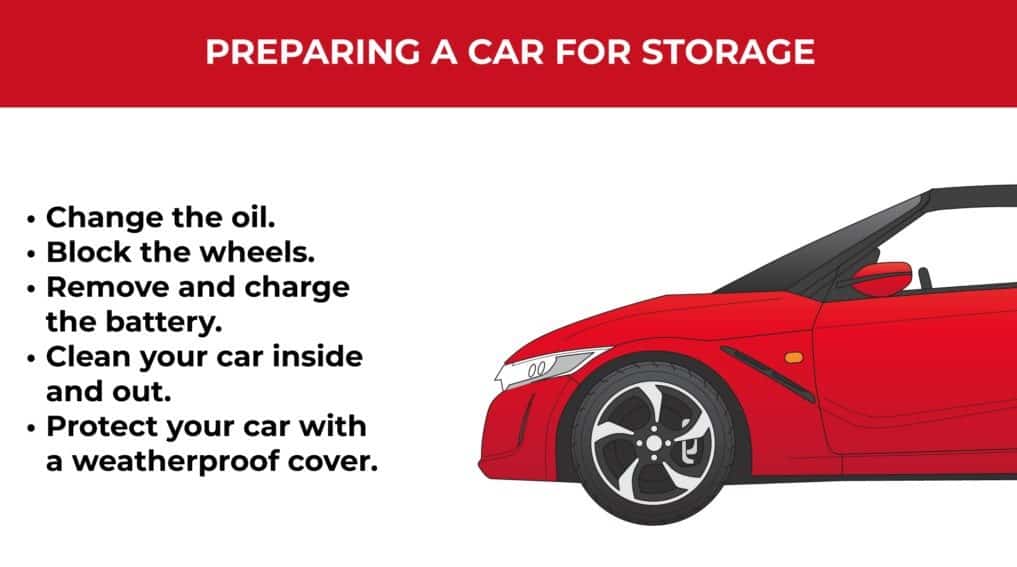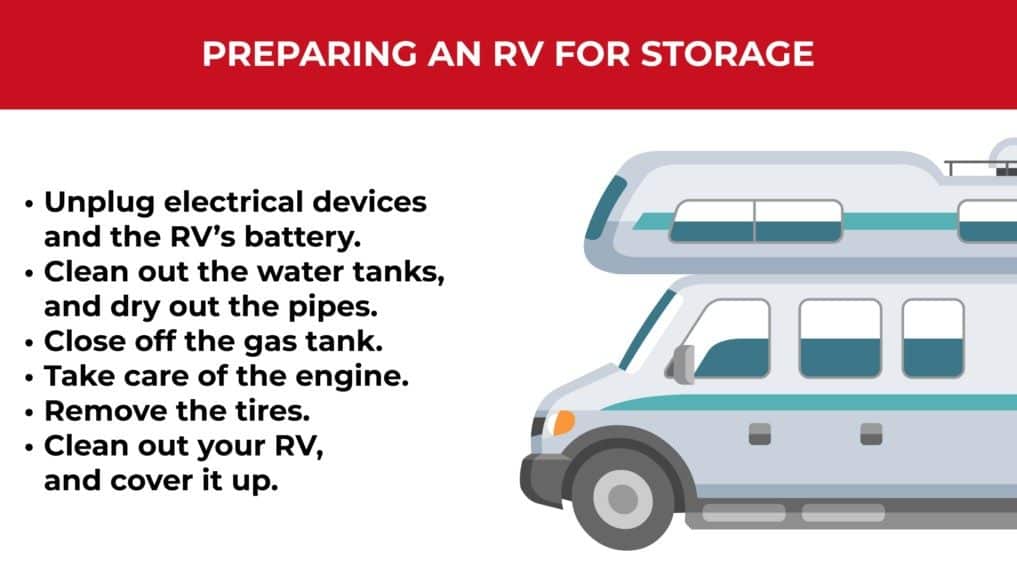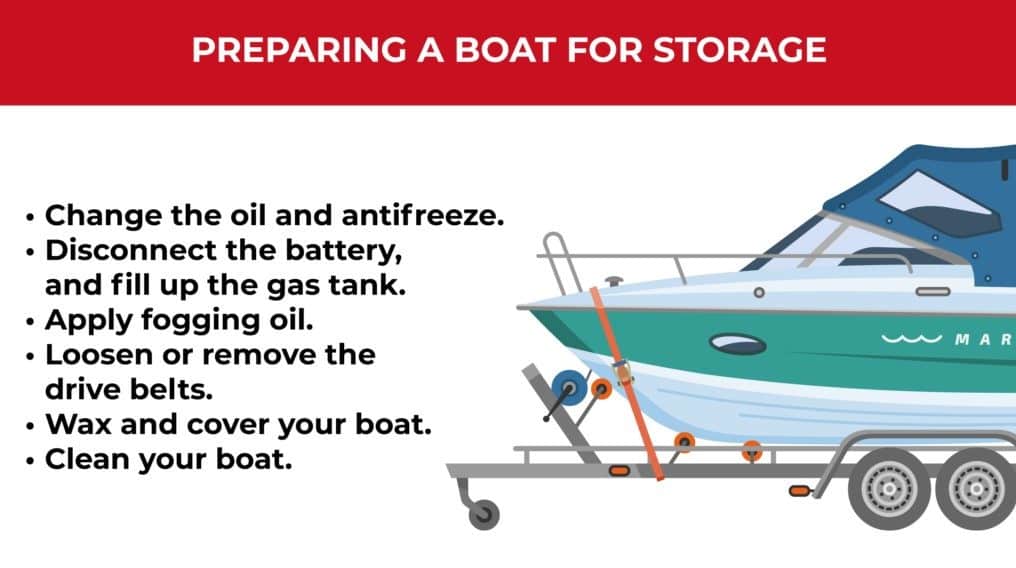No matter if you plan to keep your vehicle at home or a storage facility near you, deciding the route you want to take when it comes to car, boat, or RV storage will depend on your budget, your vehicle’s condition, and how long you plan to leave it in storage. From long-term car care to seasonal storage tips for your ride, Go Store It is here to help steer you through the process. This vehicle storage guide will cover the following topics:

Old oil contains contaminants that can settle and cause engine problems. To keep your engine in good shape, change the oil before storing your car for longer than a couple of months.
Though it may make you feel safer to do so, don’t apply the parking brake while storing your car to prevent the brake pads from fusing with the rotors. Instead, place tire stoppers behind the tires so the vehicle doesn’t roll.
Your car’s battery will lose charge over time, even if it hasn’t been running. Remove and store the battery in a warm, safe environment. Once you take your vehicle out of long-term storage, you can then reinstall the battery and let it recharge. You’ll be on the road again in no time.
You won’t want to come back to your vehicle’s storage space to find a dirty car. Not to mention, filth like dirt, water stains, bird droppings, grease, and grime can collect on your vehicle’s exterior and damage its paint over time. On the interior, crumbs, fast food bags, and more can leave permanent stains and even lure pests. In addition to cleaning the inside of your car, you should wash and wax the outside, too.
Whether you’re putting your car in a shed or a storage unit, it’s best to cover up any valuable possession you store for the long term. The cover will help protect the vehicle from dust, dirt, and debris as it sits idle for months at a time.
If possible, visit your vehicle once a month. Allow it to run for a few minutes so the fuel and oil can circulate the engine. Taking your car for a short drive every so often can also prevent flat spots from forming on the tires.
Aside from the long-term car storage tips mentioned, it’s especially important to ensure your vehicle is equipped to withstand cold temperatures if you’re storing it for the winter. Consider the following steps for seasonal vehicle storage:
With big vehicles can come big problems and costly repairs. If you’ll be storing your RV for an extended period, make sure you perform due diligence with upkeep and maintenance before parking it indefinitely or once road trip season comes to an end.

Unplug any electrical element inside your RV. Certain devices—such as alarms, microwaves, TV antenna boosters, and more—can drain the battery if you fail to turn them off. As with regular vehicles, it’s best to remove your RV’s battery entirely and store it in a room-temperature location if your area experiences freezing temperatures in the winter.
When cleaning out your RV, don’t neglect the water and sewage tanks. You can empty your wastewater and freshwater tanks, including the toilet and water heater, at a dump station. One DIY way to clean your tanks is to fill them with a solution of water and baking soda or bleach. Then, briefly drive your RV around so the liquid is able to move about the tanks, and empty them afterward. Now that your tanks have been cleaned out, dry out the pipes. Especially if you’re storing your RV during winter weather, water will freeze and expand inside the pipes, potentially causing them to burst. Although it’s not possible to dry your pipes 100%, you can send compressed air through the system to expel as much moisture as possible. (Just make sure to consult a trained mechanic or your owner’s manual before you do, as this can damage some plumbing systems.)
Top off your propane tanks, and turn off gas supplies. If you have a basement or another place that’s cool and dry, remove and store the propane tanks. Lastly, shut off any ovens, water heaters, furnaces, and other appliances that use gas.
Change or top off fluids for your RV, such as your oil, radiator, antifreeze, brake, and windshield wiper fluids. Fill your gas tank with fuel and the right amount of fuel stabilizer to help prevent corrosion and moisture buildup. Run the engine for a few minutes so the stabilizer can spread.
When your RV tires rest in the same position for a long time—particularly in cold temperatures—they may develop flat spots that could ruin them. You may be able to avoid this issue if you take your RV out for a drive every month or so. If you can’t, remove the tires and set the RV up on jacks or blocks to extend the life of your wheels.
Thoroughly clean your RV of any perishable food or remaining crumbs. Empty and unplug your refrigerator and microwave. You may even want to spray pesticides or set insect traps inside your RV while it’s in storage. Use an RV cover to protect your vehicle from dust, hail, animal droppings, and sun damage.
Hopefully, your storage space of choice will help keep your boat sheltered and in tip-top condition. However, routine maintenance and winterization can be key to ensuring your watercraft will run smoothly when you take it out on the water again.

Because your boat will remain idle for an extended period of time, perform an oil change. Plus, it’s likely that some water or acid got into your oil as you drove the boat, which could corrode your engine if not removed. Next, replace the filter, flush out the old oil, and add new oil.You should also refresh your boat’s coolant system to help stop components in your engine from freezing and corroding throughout the winter. Drain the coolant, flush out what remains with water, and add the new antifreeze, ensuring you dilute it to your boat’s specifications.
If it’s left connected, your boat’s battery can drain over the winter, so make sure to disconnect the battery. In addition, fill up your gas tank; empty tanks can collect condensation and corrode.
First, turn over your boat’s engine without actually starting it. As it’s turning over, spray fogging oil into either the carburetor or the spark plug holes (reference your owner’s manual for instructions). Doing this helps preserve your engine’s moving parts during cold weather.
Protect the drive belts on your boat. If you don’t remove them entirely, at least loosen the belts significantly before storing them. Failing to do this could cause the drive belts to stay in tension for too long when there is freezing and thawing throughout winter—which can create cracks in the belts.
Double-check that you’ve removed any standing water, debris, or organic matter from your boat to avoid rotting, molding, foul odors, and even damage. If you care to maintain its shine, give your boat a good wax, too. It’s a win-win that not only leaves the exterior looking immaculate but also helps prevent corrosion and rust. Lastly, do what you can to prevent your boat from collecting grime by covering it, whether it’s stored for the offseason or the long term.
From the shorelines of lakes around Charlotte, NC, to the coastal beaches of Bonita Springs, FL, Go Store It is here to provide car, boat, and RV storage solutions at our facilities with vehicle storage units or parking spaces available. Call us at a self storage facility near you with questions about car storage, or rent your unit online today!